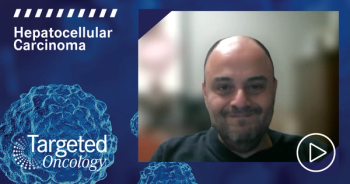
Which MOA to Use in Second-Line Treatment of mHCC
Michael A. Morse, MD, FACP:When I first started treating people with hepatocellular carcinoma, there actually weren’t any therapies. There was chemotherapy, but it was very toxic, and few people were candidates for it. We don’t use chemotherapy in the majority of patients anymore. With first-line therapy we have 2 agents, so we have a choice. But in the second line, we have 5 different therapies that are FDA approved. We have the TKIs [tyrosine kinase inhibitors]cabozantinib and regorafenib. We have the immunotherapies—nivolumab or pembrolizumab. We also have the anti-VEGF receptor antibody, ramucirumab. What this basically tells us is we have a number of choices in the second-line setting, which is great for patients.
Determining which of the second-line therapies to use is 1 of the most challenging issues in managing hepatocellular carcinoma. Keep in mind that all of them were tested in people who had prior sorafenib. In my opinion, it doesn’t matter whether you’ve had prior sorafenib or prior lenvatinib, you can use any of the second-line choices. We certainly extrapolate from the data for patients who previously had sorafenib.
But 1 issue that commonly happens is that for people with their prior TKIs, they’ve maybe had some adverse effects. I’m often asked by patients, “Well, does that mean I’m going to have the same adverse effects? Should I use a TKI or should I use an immunotherapy in this setting?” The reality is just because you have a certain experience with 1 TKI doesn’t necessarily mean you’ll have the same experience with another TKI. I think it’s actually appropriate to choose either immunotherapy or a TKI in second line.
What I do in my personal practice is discuss with patients what’s known about these drugs. None have been directly compared with each other. They were all compared with placebo or were tested as single agents, and efficacy with them led to FDA approval. Even though I just got done saying that the experience with a prior TKI doesn’t dictate experience with a subsequent TKI, I think many patients will tell me, “Well, yes, I’ve already had that TKII know what the experience was—but I want to try something different,” or, “I’ve seen immunotherapy on TV.” We certainly try to take into account what people’s wishes are. I, like many oncologists, certainly do look at some other comorbidities.
This would be if somebody had a risk factor that would make a further TKI concerning. For example, if they have uncontrolled hypertension at this point, maybe they should get an immunotherapy instead of a TKI. If they have an autoimmune diseaseand you can have autoimmune diseases and still take antiPD-1 [programmed cell death protein 1] therapies—maybe they also should receive the immunotherapies. But some people have autoimmune diseases where you’d have to be really concerned about whether to give them an immunotherapy. If they have active lupus, for example, you’d have to be a little concerned in that person.
But the bottom line is they’re all reasonable options. I tell people, “You know, if we choose 1 of these and you don’t get benefit from it, you’ve got 4 other therapies.” Maybe we’ll move on to immunotherapy if we didn’t do it in the second line, or if we did immunotherapy in the second line, maybe we’ll do a TKI in the third line.
Transcript edited for clarity.
Case: 63-Year-Old Male with R/R mHCC
February 2018: Initial presentation
- A 63-year-old man with chronic HBV infection referred for further imaging studies based on suspicious findings during routine ultrasound for HCC
Initial Clinical Workup
- AFP: 300 IU/mL
- Child-Pugh A
- Platelets: 210,000 cells/mcL
- Bilirubin: 1.2 mg/dL
- Albumin: 3.6 g/dL
- INR: 1.1
- No hepatic encephalopathy
- Ascites not present
- Imaging: CT revealed 2 lesions in right hepatic lobe (2cm, 5cm); no extrahepatic disease; no cirrhosis; no portal hypertension
- BCLC: B
- PS: 0
Treatment
- Patient underwent right hepatectomy; negative margins; no vascular invasion
- AFP: WNL
December 2018
- On routine follow-up, imaging showed new lesion in left hepatic lobe (~2.3cm)
- Chest CT showed 3 small lesions (<1cm) in upper left lobe of lung
- Patient started on lenvatinib 12 mg QD; experienced moderate diarrhea and fatigue
- Imaging at 3 and 6 months showed partial response
- AFP: 100 IU/mL
- BCLC: C
- PS: 0
August 2019
- Routine follow-up blood sample reveals AFP 450 IU/mL
- CT scan showed progression in the lung and 2 new liver lesions; remains Child-Pugh A
- Patient started on cabozantinib 60 mg QD
- Patient developed grade 2 diarrhea; dose-reduction to 40 mg QD
- Imaging at 3 months showed stable disease
- Imaging at 6 months showed partial response









































